

Master boot record. This article is about a PC-specific type of boot sector on partitioned media.

For the first sector on non-partitioned media, see volume boot record. A master boot record (MBR) is a special type of boot sector at the very beginning of partitioned computer mass storage devices like fixed disks or removable drives intended for use with IBM PC-compatible systems and beyond. The concept of MBRs was publicly introduced in 1983 with PC DOS 2.0.
The MBR holds the information on how the logical partitions, containing file systems, are organized on that medium. Besides that, the MBR also contains executable code to function as a loader for the installed operating system—usually by passing control over to the loader's second stage, or in conjunction with each partition's volume boot record (VBR). MBRs are not present on non-partitioned media like floppies, superfloppies or other storage devices configured to behave as such. Overview[edit] It may contain one or more of: Disk partitioning[edit] H. The Standard Master Boot Record. Other Microsoft MBR pages: The MBR created by Windows 95B/98/98SE and ME's FDISK The MBR created by Windows 2000/XP/2003 Installs or Disk Management Utility The MBR created by Windows Vista OS Installs or Disk Management Utility The MBR created by Windows 7 Installs or Disk Management Utility And Microsoft OS Volume Boot Records: An Examination of the Windows 95B/98/98SE/Me OS Boot Record (MSWIN4.1) An Examination of the Windows 2000/XP OS Boot Record (NTFS) An Examination of the Windows Vista OS Volume Boot Record (NTFS) An Examination of the Windows 7 OS Volume Boot Record Confused?
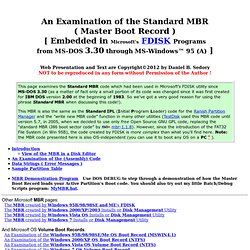
Send me an email if you have a specific question about the MBR or any Boot Records... This page examines the "standard" code (used by Microsoft prior to Windows 95B) that is written to Cylinder 0, Head 0, Sector 1 of your first Hard Drive by the so-called "undocumented" DOS command:“ FDISK /MBR .” NOTE: Not all utilities are created alike! Location of Error Messages in Memory. Tools for MBR/Boot Records and References. MBRFIX.EXE 1.3.0.0 (Author: Kåre Smith; of Systemintegrasjon AS; for Windows™ NT/2000, XP, 2003, Vista and Windows 7).

This links to a very nice page describing all the program's commands. MBRFIX.bat is a Batch (*.bat) program you can use to run some simple MbrFix commands on a Windows computer without having to first open a Command Line Interface (CLI) window. This Batch program will also record the date and time it was run, in the same way that our Sector Inspector Batch program does.
Just copy and paste the following lines into a text editor, such as Notepad, save the file as "MBRFIX.bat" in the same folder as mbrfix.exe and either double-click on the Batch program (or use "Run") to execute it. [ Note: The 'driveinfo' and 'listpartitions' commands do not provide any data about Extended ('Logical') partitions; only those listed in the MBR Partition Table (up to 4 possible entries).] PC Bootstrap Loader Programming Tutorial in ASM - OmniNerd. PC Bootsector Programming Tutorial in ASM [index] [235,154 page views] A word of caution, tampering with the bootsector of a computer can render the machine inoperable.

It is advisable to experiment using floppy disks or non-critical hard drives prior to transferring your bootsector onto a live system. Writing a boot loader in assembler - OrganicDesign Wiki. A Look At Bootstrapping. Program A Bootstrap Loader - VnutZ Domain. OSRC: The Boot Process. The Boot Process Boot sectors, bootable CD-ROMs, examples..
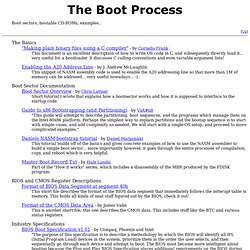
The Basics "Making plain binary files using a C compiler" - by Cornelis Frank This document is an excellent description of how to write OS code in C, and subsequently directly load it... very useful for a bootloader. It discusses C calling conventions and even variable argument lists! Enabling the A20 Address Line - by J. This snippet of NASM assembly code is used to enable the A20 addressing line so that more than 1M of memory can be addresed... very useful nowadays... :) 0. Introductions and Expectations. Bootdisk.Com. Liveusb-creator - Trac. The liveusb-creator is a cross-platform tool for easily installing live operating systems on to USB flash drives.
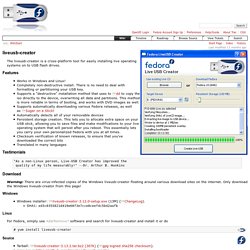
Features ¶ Works in Windows and Linux! Completely non-destructive install. There is no need to deal with formatting or partitioning your USB key. Supports a "destructive" installation method that uses to dd to copy the iso directly to the device, overwriting all data and partitions. Testimonials ¶ Boot from USB. PCs use a system called the BIOS (Basic Input/Output System) to start the machine.
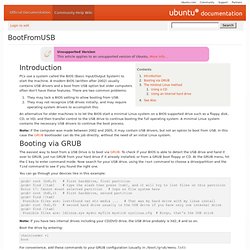
A modern BIOS (written after 2002) usually contains USB drivers and a boot from USB option but older computers often don't have these features. There are two common problems: They may lack a BIOS setting to allow booting from USB. They may not recognize USB drives initially, and may require operating system drivers to accomplish this. An alternative for older machines is to let the BIOS start a minimal Linux system on a BIOS supported drive such as a floppy disk, CD, or HD, and then transfer control to the USB drive to continue booting the full operating system. Note: If the computer was made between 2002 and 2005, it may contain USB drivers, but not an option to boot from USB. How Windows Starts Up (part 1 of 4) - Ntdebugging Blog. Hi folks, my name is David and I’m an Escalation Engineer for Microsoft.
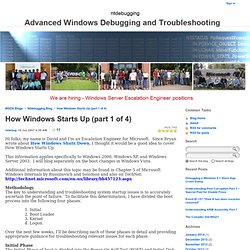
Since Bryan wrote about How Windows Shuts Down, I thought it would be a good idea to cover How Windows Starts Up. This information applies specifically to Windows 2000, Windows XP, and Windows Server 2003. I will blog separately on the boot changes in Windows Vista. Additional information about this topic may be found in Chapter 5 of Microsoft Windows Internals by Russinovich and Solomon and also on TechNet: Methodology The key to understanding and troubleshooting system startup issues is to accurately ascertain the point of failure. How Windows Starts Up (Part the second) - Ntdebugging Blog. Howdy folks, David here again with part two of How Windows Starts Up.

Today we’ll be covering the Boot Loader Phase. Let’s take a moment to recap where we are at this point. So far, the computer has completed POST, executed the MBR code, located the active partition, executed the Boot Sector code in that partition, found NTLDR and loaded it into memory. So what happens next? During this phase, we’ll be discussing the following files located in the root of your system volume: NTLDR, ntdetect.com and boot.ini. AoATOC.html. 2.7 An Introduction to the Intel 80x86 CPU Family. Inside the Linux boot process. In the early days, bootstrapping a computer meant feeding a paper tape containing a boot program or manually loading a boot program using the front panel address/data/control switches.

Today's computers are equipped with facilities to simplify the boot process, but that doesn't necessarily make it simple. Let's start with a high-level view of Linux boot so you can see the entire landscape. Then we'll review what's going on at each of the individual steps. Source references along the way will help you navigate the kernel tree and dig in further. Overview Figure 1 gives you the 20,000-foot view. Figure 1. When a system is first booted, or is reset, the processor executes code at a well-known location. When a boot device is found, the first-stage boot loader is loaded into RAM and executed.
When the second-stage boot loader is in RAM and executing, a splash screen is commonly displayed, and Linux and an optional initial RAM disk (temporary root file system) are loaded into memory. Back to top. Detailed Explanation of FAT Boot Sector. The Starman's Realm.